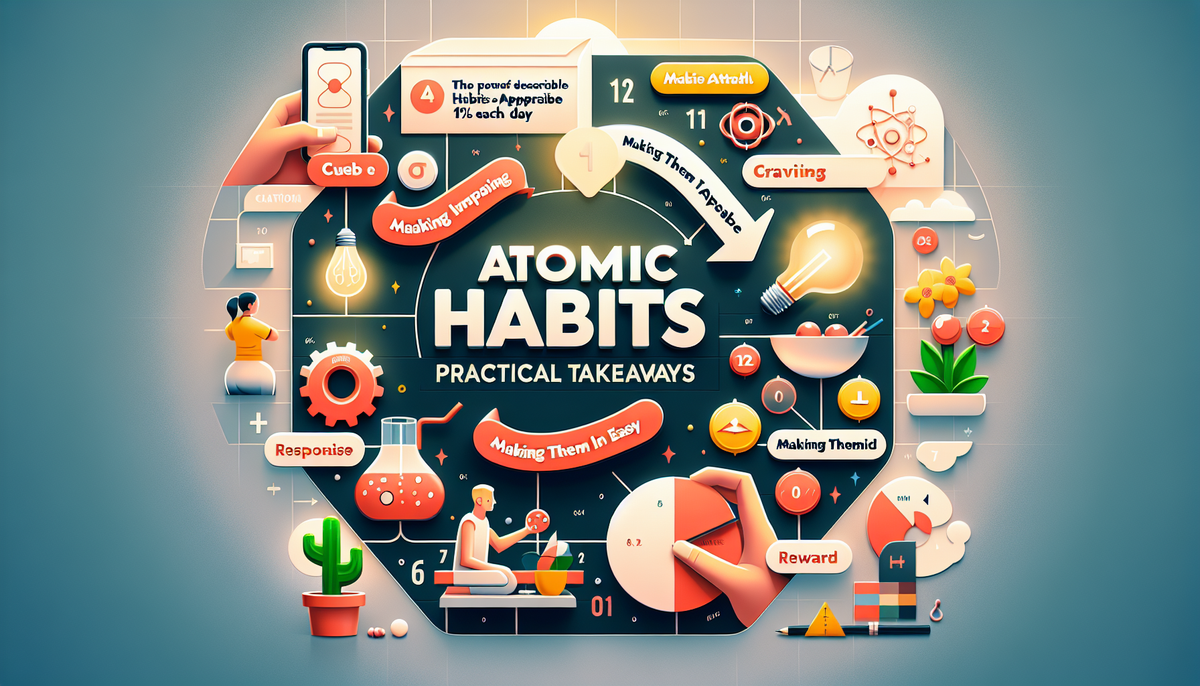Atomic Habits: Practical Takeaways

The Foundation: Why Small Habits Make a Big Difference
James Clear's "Atomic Habits" is a groundbreaking guide to self-growth, offering a practical framework for building good habits and breaking bad ones. This james clear summary explores the core takeaways for effective habit building. The central theme of the book is that minuscule changes, the "atomic habits," can compound into remarkable results. Clear argues that improving by just 1% each day leads to becoming over 37 times better in a year. This philosophy shifts the focus from setting ambitious goals to building better systems. While goals determine your direction, systems are what ensure you make progress. This fundamental concept is the starting point for transforming your life through deliberate, consistent action.
The 1st Law: Make It Obvious
The first law of habit building is to make the cues for your desired habits obvious. A cue is anything that triggers a habit, and increasing your exposure to positive cues makes it easier to act. To effectively implement this law, you must first become aware of your current behaviors.
The Habit Scorecard
A powerful technique for this is creating a "Habit Scorecard." This involves listing your daily habits and categorizing them as effective (+), ineffective (-), or neutral (=). This simple exercise raises your awareness, preventing unconscious, negative routines from running your life. It’s the essential first step in any habit building journey, as you can't change what you don't acknowledge.
Designing Your Environment for Success
Environment design is a cornerstone of making cues obvious. If you want to practice guitar, place the guitar stand in the middle of your living room. If you want to drink more water, put water bottles in common areas of your home. By making the cues for your habits a visible part of your environment, you reduce the reliance on motivation and make the behavior almost automatic.
The Power of Habit Stacking
Habit stacking is a strategy to link a new habit with one you already do. The formula is: "After [Current Habit], I will [New Habit]." For example, "After I pour my morning coffee, I will meditate for one minute." This anchors your new, desired habit to a well-established one, using the momentum of the old habit to carry you into the new one, making it a seamless part of your atomic habits system.
The 2nd Law: Make It Attractive
The second law is all about making the habit you want to adopt irresistible. The more attractive a habit is, the more likely you are to experience a craving for it, which is the motivational force behind every habit. For successful habit building, you need to associate good habits with positive feelings.
Using Temptation Bundling
Temptation bundling is a highly effective strategy to make your habits more attractive. It works by linking an action you *want* to do with an action you *need* to do. For example, "I will only listen to my favorite podcast while I am exercising." By bundling the two, the allure of the "want" action pulls you through the "need" action, making the entire process more appealing.
The Influence of Social Norms and Culture
Humans are herd animals. We are heavily influenced by the people around us. You can make your habits more attractive by joining a culture where your desired behavior is the normal behavior. If you want to get fit, surround yourself with fit people. If you want to read more, join a book club. When you see others performing a habit, it becomes more attractive to you.
The 3rd Law: Make It Easy
The third law of behavior change is to make your habits as easy as possible to perform. Human beings are wired to follow the law of least effort; we naturally gravitate towards the option that requires the least amount of work. To build better atomic habits, you must decrease the friction associated with them.
The Law of Least Effort
To reduce friction, simplify your habits. If you want to eat healthier, chop up fruits and vegetables on the weekend and store them for easy access. If you want to go to the gym before work, lay out your gym clothes the night before. By preparing in advance and removing steps between you and the good habit, you make it easier to follow through.
The Two-Minute Rule to Stop Procrastinating
A key strategy for making habits easy is the "Two-Minute Rule." It states that when you start a new habit, it should take less than two minutes to do. "Read before bed" becomes "Read one page." "Do thirty minutes of yoga" becomes "Take out my yoga mat." The idea is to master the art of showing up. Once you've started doing the right thing, it is much easier to continue doing it.
The 4th Law: Make It Satisfying
The final law of habit building is to make the habit satisfying. We are more likely to repeat a behavior when the experience is satisfying. The problem is that the rewards of good habits are often delayed, while the rewards of bad habits are immediate. The key is to find a way to bring immediate gratification to your good habits.
The Cardinal Rule of Behavior Change
What is immediately rewarded is repeated. What is immediately punished is avoided. To make a habit stick, you need to feel successful. A simple way to do this is to give yourself an immediate reward after completing your habit. For instance, after you finish a workout, you could enjoy a delicious, healthy smoothie. This reinforces the behavior and closes the habit loop.
How to Stay Motivated with Habit Tracking
Habit tracking is a simple but powerful way to make your habits satisfying. Visually tracking your progress—whether by putting an 'X' on a calendar or using a habit-tracking app—creates a satisfying visual cue of your progress. It shows you're making headway and encourages you not to "break the chain," which provides immediate satisfaction and fuels your long-term commitment to habit building. This technique is a cornerstone of this james clear summary of practical takeaways.



